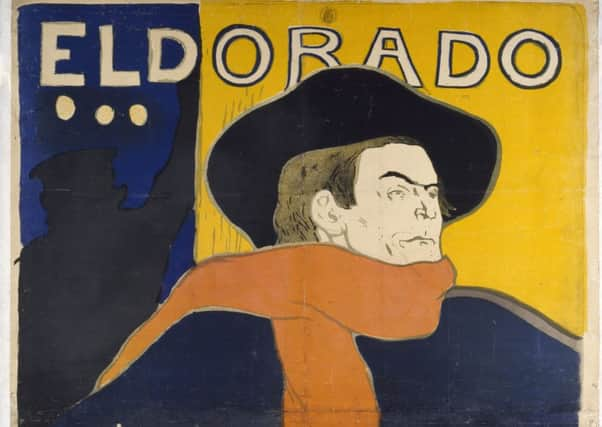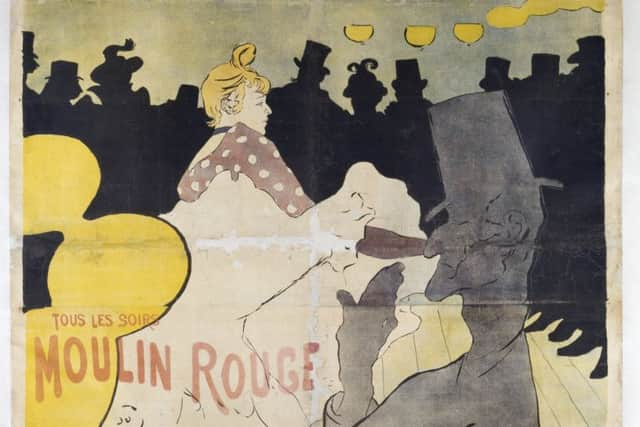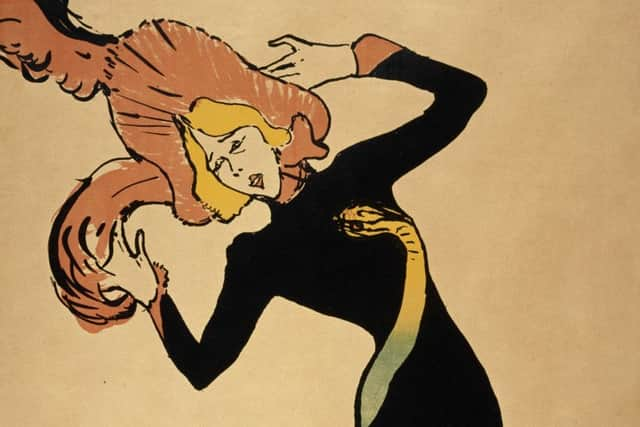New NGS exhibition shows how Toulouse-Lautrec captured the essence of fin-de-siècle Paris


In 1882, a young man arrives in Paris. He is immaculately dressed, but he is short in stature and walks with a cane. He is here to train as an artist, having secured a place at the studio of Leon Bonnat in Montmartre, the throbbing, bohemian heart of the city. Henri Marie Raymond de Toulouse-Lautrec-Monfa is about to begin a new life.
Raised in an aristocratic family in southern France, plagued by ill-health and cossetted by an over protective mother, Toulouse-Lautrec, alone in Paris at the age of 18, breathed the air of freedom. Soon, he would have his own apartment in Montmartre where he would host an eclectic crowd of artists and bohemians. A regular at the cabaret clubs and theatres, he would immerse himself in this world and – perhaps more than anyone else, and with greater insight – he would capture it in his art.
Advertisement
Hide AdToulouse-Lautrec was a prolific and talented painter – at his early death, he left an oeuvre of more than 700 paintings. But it is the posters he designed for the nightclubs and music halls of Paris which have most become part of the public imagination. An exhibition focusing on these, Pin-ups: Toulouse-Lautrec and the Art of Celebrity, opening at the National Galleries of Scotland next weekend, explores how his posters and prints were much more than just publicity: they lift the lid on the tawdry glamour of fin-de-siècle Paris and its stars.


Hannah Brocklehurst, curator of drawings and prints at the National Galleries of Scotland, says: “At this time, artists were choosing to work outside the Academy and promote themselves, the traditional forms of patronage were changing. In the same way that the celebrities had to work hard to promote themselves in a crowded market, so did the artists. Doing posters catapulted Toulouse-Lautrec into the public eye. I suppose you could think of the images as being celebrities in their own right because they’re still famous now, more so than the actual performers.”
Although he could not have known it, Toulouse-Lautrec arrived in Paris at just the right moment. The city was changing. A relaxation of licensing laws and an increase in leisure time was fuelling a new kind of entertainment. The Cafe-concerts painted by Manet and Degas had spawned a new generation of theatrical entrepreneurs, opening venues such as the Chat Noir, Eldorado, the Folies-Bergère and, of course, the Moulin Rouge. With them came a new generation of street-savvy performers who knew just as well as today’s celebrities the value of good publicity.
“Talent wasn’t even necessarily the most important factor,” says Brocklehurst. “It wasn’t necessarily the best singer or the best looking person that would capture the public heart because people liked the idea of an underdog. Many of them came from working-class backgrounds. They could thrive on the cult of personality.”
The outrageous La Goulou drank the drinks of people in the audience and once addressed the visiting Prince of Wales with the salutation: “Oy! Wales!” Yvette Guilbert made up for her poor singing with glamour and a spoken-voice singing style. Jane Avril suffered from St Vitus’ Dance, but simply incorporated any involuntary jerky movements into her dance routine, and went on to become lead dancer at the Moulin Rouge. In this world, where eccentricity and difference were celebrated, a small man who had to walk with a cane could find his place in the world.


That place was a table kept permanently reserved for him at the Moulin Rouge, and an apartment in Montmartre where he entertained lavishly. Disliking flowers on the table, he decorated with bowls of goldfish. He is credited with inventing the Earthquake cocktail – a dangerous mix of cognac and absinthe – and a friend published a book of his recipes after he died. When Moulin Rouge wanted a new kind of poster, he was their first port of call.
Advertisement
Hide AdThe poster as we know it was relatively new. Jules Cheret, “the father of the poster,” had introduced large-scale colour lithography to Paris in the 1880s and traditional black and white playbills were being replaced with colourful illustrative advertisements. Guidelines on the display of publicity materials in public spaces had been relaxed, and the city was being described laughingly by some as “the people’s Louvre.” Young artists were working avidly in the new medium, so much so that Camille Pissarro, writing from Paris in 1897, complained that “the young don’t make anything else”.
But Toulouse-Lautrec would take the poster to new heights. His first, created for the Moulin Rouge in 1891, showed both artistic daring and a savvy eye for the power of celebrity. Featuring La Goulue dancing, with a silhouette of her dance partner, Valentin le Désossé, in the foreground, he chose a daring composition and a palette of acidic tones.
Advertisement
Hide AdHannah Brocklehurst says: “These stars were well known enough to the public that, by putting them on the poster recognisably as themselves, he was marketing the venue through the use of their image. Toulouse-Lautrec is realising the power of the celebrity image, which is what he continues to do in his publicity posters. There was a legendary moment when about 3,000 of these were posted up across Paris overnight and people woke up in the morning to find it everywhere. Everyone was talking about it – and about Toulouse-Lautrec.”
He achieved this time and again in his posters, capturing the essence of the stars by their signature tropes – Yvette Guilbert’s long black gloves, Aristide Bruant’s ubiquitous scarf. The talent he had shown for caricature as a teenager was used to capture performers in a way that was instantly recognisable. He got to know them well and worked on collaborations, such as two albums of lithographs of Yvette Guilbert. And the publicity machine helped bring some of them worldwide fame; they gave interviews, wrote rags-to-riches memoirs and scandalised their fans, much like today’s celebrities.
Toulouse-Lautrec not only made images which sold entertainment, he also captured something of the essence of the world in which he moved, its tawdry glamour and edge of danger. Brocklehurst writes of that iconic first poster: “Lautrec’s design conjures up the real-life appeal of the Moulin Rouge – performers who were not sweet or conventionally pretty, but were gaudy, disreputable and indeed had a darker side. The venue itself teetered between the dangerous and the decadent, the licit and the illicit, a tension which the uneasiness of Lautrec’s design conveys with great perception.”
Toulouse-Lautrec died at the age of just 36, of a stroke complicated by alcoholism and syphilis. But – long after the theatres have closed down, and the stars been confined to dust – his posters continue to be copied and displayed throughout the world. Ironically, his name has endured longer than any of those he drew and painted. The little man with the cane spent his time shaping the celebrity of others, but he also managed to achieve it for himself.
Pin-Ups: Toulouse-Lautrec and the Art of Celebrity, Royal Scottish Academy, until 20 January 2019, www.nationalgalleries.org